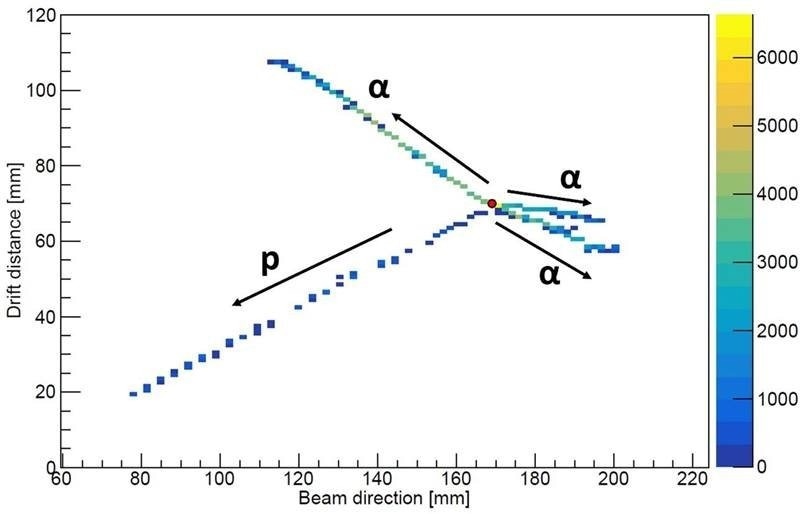The existence of all the material around is not stable. Few materials might experience radioactive decay to develop highly stable isotopes.
 Image of particles that have emerged from the nucleus after it undergoes beta decay from this new decay mode. The resultant nucleus has broken apart into three helium nuclei (α) and one proton (p) originating from a single decay point (red circle). Image Credit: J. Bishop.
Image of particles that have emerged from the nucleus after it undergoes beta decay from this new decay mode. The resultant nucleus has broken apart into three helium nuclei (α) and one proton (p) originating from a single decay point (red circle). Image Credit: J. Bishop.
Currently, researchers have noted a new decay mode initially. In this decay performed, a lighter form of oxygen, oxygen-13 (with eight protons and five neutrons), decays by breaking into three helium nuclei (an atom in the absence of the encircling electrons), a positron (the antimatter version of an electron), and a proton.
Researchers noted this decay by watching a single nucleus break apart and quantifying the breakup products.
The Impact
Earlier, researchers have noted fascinating modes of radioactive decay after the process known as beta-plus decay. This is where a proton converts into a neutron and liberates a few of the produced energy by discharging an antineutrino and a positron.
Following this initial beta-decay, the consecutive nucleus could have sufficient energy to boil off additional particles and make itself highly stable.
This new decay mode is the initial observation of three helium nuclei (alpha particles) and a proton emitted after beta decay. The findings could inform researchers regarding decay processes and the properties of the nucleus before the decay.
Summary
In this experiment, scientists utilized a particle accelerator called a cyclotron at the Cyclotron Institute at Texas A&M University to generate a beam of radioactive nuclei at high energies (around 10% of the speed of light).
They transmitted this beam of radioactive material, oxygen-13, into a piece of equipment known as the Texas Active Target Time Projection Chamber (TexAT TPC). The material stops within this detector, which has been filled with carbon dioxide gas, and decays after nearly ten milliseconds by liberating a neutrino (beta-plus decay) and a positron.
By implanting the oxygen-13 into the detector, one nucleus at once, and waiting for it to decay, the scientists quantified any particles that boiled off after the beta-decay utilizing the TexAT TPC.
Then, the researchers examined the data with a computer program to determine the tracks the particles leave in the gas. This enabled them to determine the rare events (happening just once per 1,200 decays) as those where four of the particles are liberated after beta decay.
This study was financially supported by the Department of Energy Office of Science, Office of Nuclear Science, and the National Nuclear Security Administration through the Center for Excellence in Nuclear Training and University-Based Research (CENTAUR).
Also, several authors acknowledge travel assistance from the IBS grant and the National Research Foundation of Korea grant, both financially supported by the government of the Republic of Korea.
Journal Reference:
Bishop, J., et al. (2023) First Observation of the β3αp Decay of 13O via β-Delayed Charged-Particle Spectroscopy. Physical Review Letters. https://doi.org/10.1103/PhysRevLett.130.222501